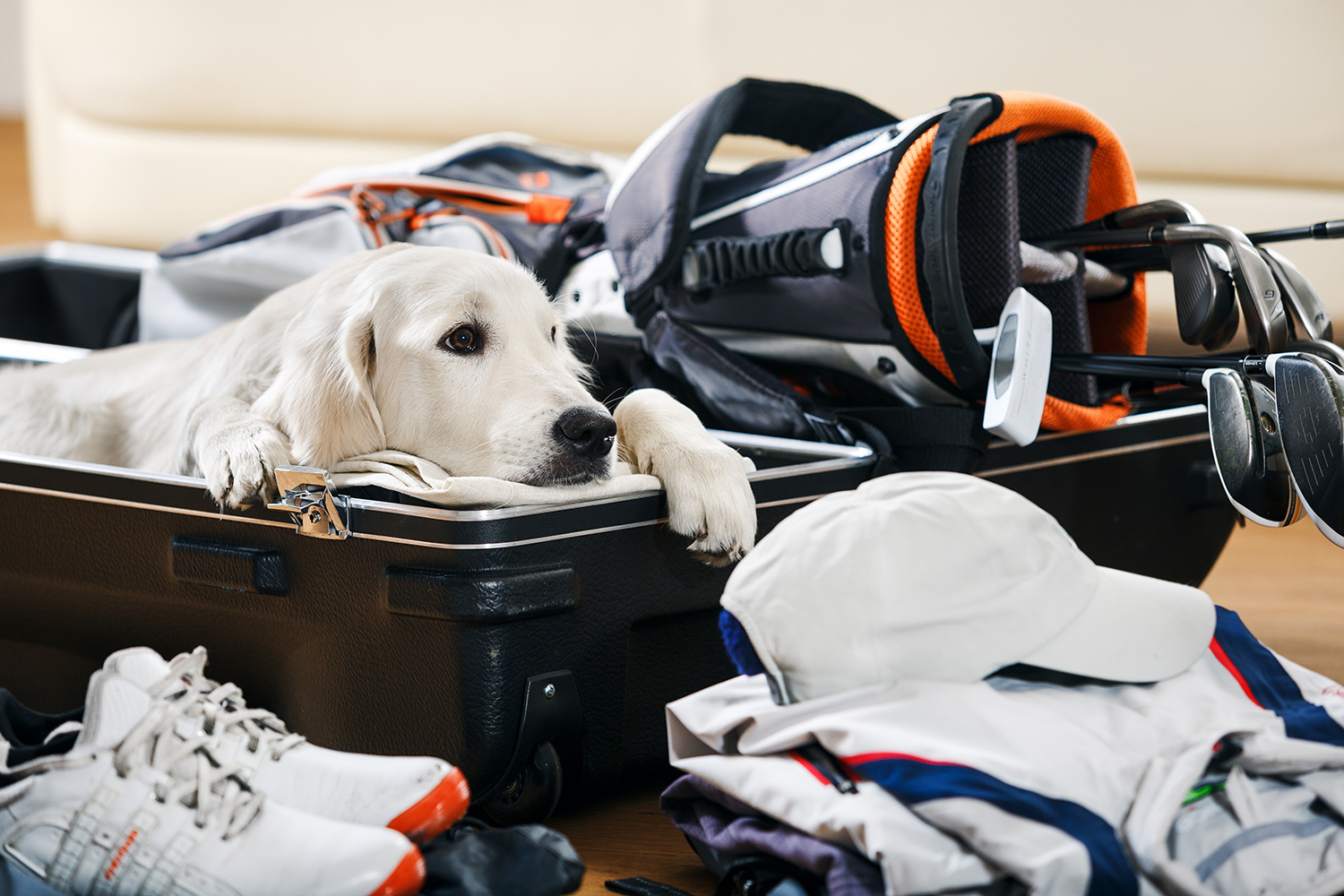Tee times at links courses in the British Isles have never been in higher demand. If you’ve managed to get an overseas golf trip scheduled, congratulations! Whether you used a golf tour operator (highly recommended) or arranged everything yourself, by snagging those tee times, booking hotel rooms, and arranging your ground transportation, you’ve done the hard part. Now you want to maximize your enjoyment of your time across the pond.
To help with that, I’ve put together a checklist that covers everything you’ll want to consider when packing for this kind of trip. Your list will vary depending on the time of year you’re traveling and the number of rounds you plan to play. But know this: You can get all four seasons in one day on a links course. And it’s almost certain that you’ll experience at least some rain. So, packing for your overseas golf trip won’t be as simple as it would be for one to warmer climes. But armed with this list, you’ll have a good idea of what to bring—and just as importantly—what to leave home.

EQUIPMENT
Protective Golf Travel Bag
All golf travel bags are not created equal. And the last thing you want is to get to your destination, pick up your clubs at baggage claim, and discover that a few of their shafts have gotten snapped. Choose a travel bag with good padding, sturdy wheels, and enough room to jam a pair of shoes and your rain gear in it. One with a TSA-approved lock is a bonus.
Lightweight Golf Bag
Few links courses offer riding carts—or in UK parlance, buggies. You’ll be walking. And whether you plan on hiring caddies, carrying your bag, or pushing/pulling a trolley, you’ll want something light in weight. Unless you’re an inveterate minimalist, Sunday bags and pencil bags aren’t the right choice. You need a bag with enough storage room for the gear you’ll need on the course, including your rain gear. If you don’t have a bag that’s super-light with good storage capabilities, this would be a good time to purchase one.
The Right Clubs
Would it make sense to alter the makeup of your set before taking a links golf trip? Given the tight nature of links turf and the typically windy conditions you’ll encounter on a links course, maybe. Pros certainly do—especially with their wedges. Amateurs may want to consider leaving the 5-wood at home and replacing it with a driving iron that’ll stay under the wind. You may want to consider reducing the loft on your driver for the same reason. Think about your wedges, too. Pot bunkers are deep; having a 60-degree wedge is a good idea. So are wedges that offer a good bit of bounce that will help prevent them from digging in on links turf. If you have the option, think about the makeup of your set before your trip.
Plenty of Balls
Bring all that you think you’ll need. And a dozen more. Balls are substantially more expensive overseas than they are in the U.S. Stock up here, lose them there.
Rangefinder or GPS Watch
Many links courses have yardage markers and posts, and almost all of them offer Strokesaver guidebooks. But you’re better off knowing exact yardages to fairway and greenside bunkers, burns, and hole locations.
Two Pairs of Golf Shoes
Given how likely it is that you’ll encounter a soaking rain during one of your rounds, you’ll want to bring two pairs of golf shoes. Golf shoes don’t dry out quickly, and the last thing you want to do is step into a pair of damp shoes the next day before walking 18 holes on firm links turf.
Rain Gloves
Your average new cabretta leather golf glove should easily last through 10 or more rounds, so it should hold up for the duration of your trip. But having a pair of rain gloves handy is a must. Bring them and hope you don’t need them.
Bag Towel
If you don’t already have a towel on your bag, get one. Clean clubs are happy clubs—and this goes not just for clubfaces but grips, too.
CLOTHING
A Few Shirts
Because the weather can be so unpredictable in the British Isles, you’ll want to plan accordingly. But that doesn’t mean you have to go overboard. Bring one short-sleeve polo shirt, one long-sleeve polo shirt, a long-sleeve thermal under layer, and a couple of dressier collared shirts for evenings. Then, buy a few shirts as you go along from the courses you visit to get you through the week.
Just Enough Trousers
Unless you’re traveling in July or August, it’s unlikely that you’ll need to pack a pair of shorts. Some clubs don’t even allow them. Two pairs of trousers for golf and another for après-golf should see you through.
Socks Galore
Given that you’ll be doing a lot of walking, you’ll want to bring comfortable, breathable socks for golf. You should be able to get away with one pair of socks per day; whichever pair you wear for dinner the night before can be worn for golf the day after. But bring an extra pair or two just in case.
A Variety of Hats
Bring two: a billed hat and a bucket hat. Bucket hats are great in the rain (if it’s not too windy), and especially if you wear glasses. Again, you can buy a hat or two along the way if you see one you like. Depending on the time of year you’re traveling, a wool beanie can be a good call, too.
Lightweight Sweater
Because layering can be so important on links courses, you’ll want to have a lightweight sweater on hand for the days when your thermal layer and polo short aren’t enough.
Performance Q-Zip
As an alternative to a sweater, a quarter-zip pullover is a good option. Many are made with highly breathable performance fabrics that are lightweight yet warm—and easy to swing in.
Jacket & Tie?
Will you be playing at a club that requires gentlemen to arrive and/or dine in jacket and tie? Are you sure? Different clubs have different policies. Make sure you know what they are before leaving home so that you’ll be dressed appropriately.
Reliable Rainsuit
Don’t be that guy who thinks a windshirt will be enough to get you through your days on the links. It won’t. Pack a good rainsuit consisting of both top and bottom. Again here, you want one that’s lightweight, breathable, and not constrictive. Good rainsuits aren’t cheap, but consider it an investment that will pay big dividends when that almost inevitable downpour happens.
MISCELLANEOUS
Sunglasses
It’s possible—and even likely—that you’ll encounter sunshine of the non-liquid kind at some point on your trip. Bring sunglasses that protect your eyes and let you see your targets clearly.
UV-Protective Sunscreen
You may only need it for your face, but be sure to have SPF 50-plus sunscreen along to protect it from the sun’s harmful rays.
Lip Balm
Windy days on the links can be murder on your lips. Grease them up with a good lip balm before teeing off and again at the turn.
Pain Killers
Unless you regularly walk your course—and even if you do—playing a succession of links courses over the course of a trip can call on muscles that don’t normally get that much of a workout. Having Ibuprofen and/or Naproxen and/or Acetaminophen and/or some arthritis cream or gel is a strong play. Some of these may also come in handy if you have a little bit too much fun exploring the single malt selection at 19th holes.
Power Cords
Bringing your phone and maybe a laptop? Don’t forget your power cords. Yes, you can buy replacements at the airport (at exorbitant prices) or go shopping at your destination. But who wants to do that when there’s golf to play and sights to see?
Power Adapters
Most laptops and cell phones don’t require power converters to use the 230-volt outlets in the UK and Ireland. But you will need plug adapters so that you can plug your U.S. devices into the three-pronged outlets there.
Debit Card
The best way to get currency in the British Isles is by using your debit card at an ATM. Currency exchanges charge fees higher than banks do, and in some cases, U.S. banks have reciprocal relationships with overseas banks that will let you avoid fees altogether. Check if yours does.
Plastic Bags
Bring one plastic bag for your dirty laundry to go into, and a couple of gallon-sized Ziplock bags to store your phone/wallet/watch in when you put them in your bag prior to teeing off. Water prides itself on finding unprotected valuables.
Apple AirTags
Nothing can ruin a trip faster than luggage that’s been lost or misplaced. Stick one Apple AirTag in your checked bag and another in your golf travel bag. When the airline misplaces one (or both), you’ll be able to tell it right where to find them.
Passport
This is the definitive don’t-leave-home-without-it item. No amount of sweet-talking will get you into a foreign country if you don’t have your passport. Check that you have it before you leave the house, when you get into your car, when you get to the airport, etc., etc. Guard it with your life. And do the same when you’re overseas so that U.S. Immigration will wave you through with a smile when you return home from your unforgettable trip.
What else would you add to this overseas golf trip packing list? Anything you would remove? Tell us your thoughts in the comment section.






Include a short bungee cord with hooks. Many ‘buggies’ (pull carts) don’t have straps to secure your bag. The bungee cord will keep your bag on the cart.
You are going to be losing golf balls so consider using less expensive balls. To cut baggage weight on your return trip, consider adding a sleeve of balls to your tip if you are confident you brought enough balls. Golf in Ireland and Scotland is not just for the wealthy. Your caddy will often be a club member earning money for club membership and greens fees. Balls are good tips (unless they marked your ‘lost’ balls and plan to retrieve them later.). Four sleeves of balls weigh @21 oz. A boxed dozen weigh 23 oz. Four dozen balls weigh about 6 lbs. In your bag put your balls in plastic bags or deal with wet, wet cardboard.
Bring local cash for the caddies, they don’t take cards. Ask the pro shop for guidance on the tip.
I always bring a few long cable ties which come in handy if I rent a trolley and need a place to hang my towel and range finder.
I also bring a few ball markers from my home club which make good gifts for other golfers if they’ve been nice, e.g. invited me to play a round.
Last tip: with the right two bags you can fit two sets of clubs in a Sun Mountain Glider. The trick is to put most of the irons in one bag, some upside down.
Just returned from ten days in Scotland, which included two rounds on the Old Course in St. Andrews, one bad weather and one perfect. Loved both. I planned my trip and ironically included most of what you outlined in your article. I do want to add a couple of things. First, several years ago we obtained Global Entry from US Customs. It cost $100 for five years and includes TSA PreCheck (which on its own cost $85). When we returned last week into Newark there were passengers from several international flights in long customs lines. With GE we went through customs in 50 seconds, literally. The second item is called CLEAR. They are in most major airports. As a member, you go to their section where they scan your face and hand walk you to the TSA agent for PreCheck, and you get in front of those in line there. Our security experience in New Orleans, and after Customs in Newark took less than five minutes. By the way, if you go to the UK rent a car. It’s easy to adapt to the “right side steering wheel left lane of the road? thing. And it opens doors to things you’d never see otherwise. Hope this is helpful.
Driving in Scotland is an adventure, and even more so in some parts of Ireland where the rural roads seem barely wide enough for two cars to pass each other. Most rental cars are manual transmission, but you may be able to get an automatic if you reserve it well in advance, giving you one less thing to distract you.
Most cars in Europe are pretty small, and may not have enough room for even two suitcases and 2 sets of golf clubs. A van may be more expensive, and harder to maneuver and park, but you’ll appreciate the extra storage space.
Even if you’ve driven on the opposite side of the road before, it’s really important to have your front seat passenger help you with navigation. One mistake could be your last. Be very careful, even if you’re just walking across the street.
I may have missed this in the post, but be sure to bring the best rain umbrella that you can afford.
1) Assume you will be walking on every course. Take the time to get in walking shape BEFORE you go. This takes time. Three walking rounds before you go won’t cut it. (DON’T ignore this…it can ruin your trip.)
2) Make damn sure you are NOT wearing new golf shoes. Take the time to break them in. I don’t care how good a golfer you are; no one plays well with blisters. (This can ruin your trip too.)
3) Just like shoes, bring more than one golf glove.
4) Start buying what you need as soon as you are confirmed to be going. Don’t wait until the last minute to buy what you need: It might not be available, might be out of season, or it’s not arriving before you leave. Don’t assume, and spread the costs over time.
5) Make sure you have a current handicap certificate, or you know how to quickly access on your phone. Yes… Some courses do check. Verify with the course in advance.
6) Some airlines offer certificates you can use so your clubs fly free. (I discovered this one by accident.) If you don’t find one, call and ask the airline.
7) Snacks. there is no “make the turn” like the US. It’s out and back. Acquire when you get there.
8) Seasonal items: Winter golf gloves, Bug Spray
9) Guys: Vaseline for chaffing deterrent…you are doing a LOT of walking. How well are you going to play golf when you have to walk like an old cowboy? On the other hand, your playing partners may be laughing so much, you beat them. (Yep, another simple thing to address that can ruin a trip if you ignore.)
10) Medications: Take more than the days you plan to be there. Travel happens.
11) Passport: If your passport will expire within six (6) months of your arrival, get that thing updated NOW. (Assume 6-8 week turnaround.)
12) Local Currency: Tips for caddies, and not everyplace you will do for dinner, etc. takes cards. Or the establishment may not take your card.
13) Gifts: For cadies, great service at dinner and/or for the club you are playing at as a guest. e.g. ball markers from your home course, flag pins for your country/state/city. etc.
14) (I couldn’t stop at 13.) Put your mind in the right space before you leave. Travel happens (you can’t do anything about it); however, you are in complete control of how you respond. Some of the best experiences I have ever had were not planned. (And they are usually the best stories, memories, and smiles.)
Most rain gloves do not keep your hands dry—and then by definition warm. Avoid the misery by buying dishwashing gloves for a few bucks at the supermarket. Weird colors yes, but who cares, you’ll never see these folks again.
Also recommend waterproof golf shoes vs two pair.